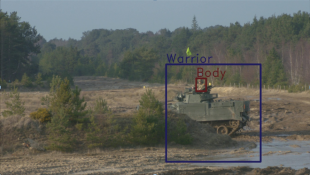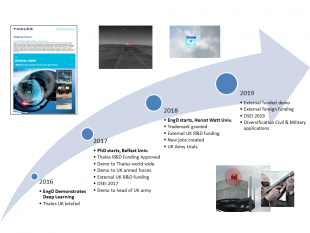Post date:
Thales is a global technology leader in the Aerospace, Transportation and Defence & Security markets. With its 30,000 engineers and researchers, out of a total workforce of 80,000, Thales has a unique capability to design, develop and deploy equipment, systems and services that meet the most complex requirements. Thales in the UK is a team of over 6,500 experts, including 4,500 highly skilled engineers, located across 10 key sites.
Thales is investing heavily in the four technological pillars of connectivity/IoT, Big Data, artificial intelligence (AI) and cybersecurity. Today, Thales is developing solutions for tomorrow’s data-driven, autonomous, immersive world – from autonomous platforms to collaborative combat systems, from connected cockpits to secure clouds and cyber-protected communications, from self-learning radars to virtual reality solutions for training and predictive maintenance.
Each year Thales invests over £575 million into its UK supply chain, working with over 2,000 companies. Dedicated to research and technology and working with our partners, together we invest over £130million in R&D in the UK annually.
Thales group develop AI applications across all domains including aerospace, defence, security, space, and transportation. In aerospace AI is used for flight pattern optimisation; in defence smart sensing apps perform automatic detection and recognition using AI; physical and cyber security applications rely on AI for advanced analysis and forensics; AI is used in space for earth image interpretation; and in transportation AI is used for traffic flow analyses and to provide passenger services. Even internally within Thales, AI is used to improve our engineering, operations, and manufacturing processes.
Within Glasgow, our users operate military land vehicles in complex, hostile environments. In addition to undertaking their primary mission, they also need to maintain communication links with base while continually maintaining an awareness of their surroundings (Figure 1). Modern military land vehicles have many tens of imaging sensors each with different fields of view operating in various modalities. The crew have no spare cognitive capacity to observe all information available, let alone exploit it. We are continually looking for opportunities to reduce the cognitive burden on the crew, to improve the operating efficiency of the vehicle. We would like to provide a system that automates the observation of all sensors and distils all available information into succinct, prioritised warnings and alerts of threats in the vicinity of the vehicle (Figure 2).
The UDRC has been particularly beneficial in supporting Thales’ vision for machine learning and AI in its applications. Thales enjoys many benefits from this relationship including a cost-effective way to advance our research capability, access to world-leading academic research groups, and the ability to define the industrial challenge. Thales has supported UDRC EngD and PhD students in each phase of the UDRC, and has gone on to recruit a number of doctoral students from these programmes.
Through a series of PhD and EngD students we have studied a variety of topics in contextual scene understanding, image segmentation, and heterogeneous processing. In 2016, a UDRC EngD student, Iain Rodger, supervised by Prof Neil Robertson at Heriot-Watt University and Barry Connor at Thales gave a demonstration of their work on the use of Deep Learning algorithms applied to a Thales thermal imaging sensor. The results were promising and generated a lot of interest within Thales, locally and globally. The Executive Committee were briefed and a Proof of Concept demonstration was developed. This demonstration was shown to the Thales Group CEO, and was presented at DSEI 2017, the world-leading defence and security exhibition where it gained significant interest (Figure 3).
The UDRC supported doctoral students has resulted in Thales developing a new product: Digital Crew®, now a registered trademark. This has been further developed in conjunction with a number of UK and international governments and partners. Two current UDRC doctoral students are looking into topics to further extend the capability of Digital Crew®. Thales is actively recruiting PhD students across the UK, and look forward to continuing to work with UDRC, and future cohorts of students, as this work continues to develop.











